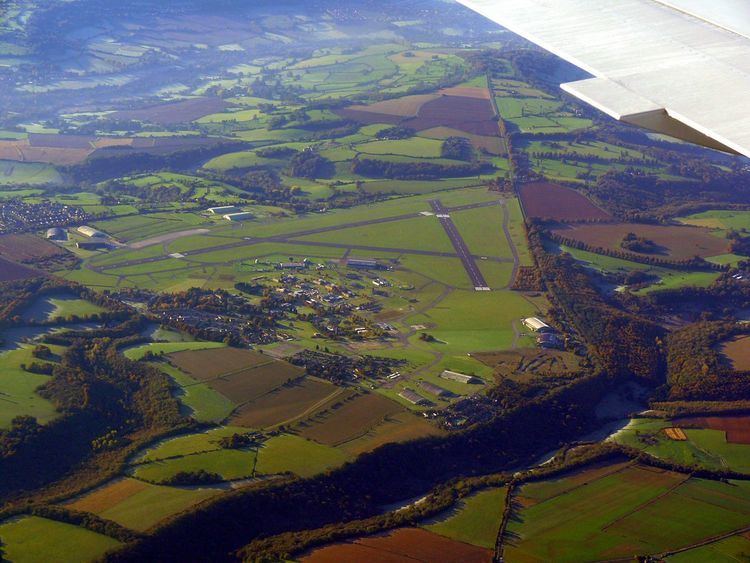Airport type Military Location Colerne, Wiltshire Elevation AMSL 581 ft / 177 m Year built 1939 Part of No. 10 Group RAF | Operator Royal Air Force In use 1940 - 2006 00/00 0 Owner Ministry of Defence | |
 | ||
Address Redwood Way, Colerne, Chippenham SN14 8HT, UK | ||
wwii warbirds p 51 and spitfire walkaround at raf colerne
RAF Colerne, now known as Colerne Airfield or AEF Colerne, is a former Second World War RAF Fighter Command and Bomber Command airfield located on the outskirts of the village of Colerne, Wiltshire.
Contents
- wwii warbirds p 51 and spitfire walkaround at raf colerne
- Raf colerne weather unit mosquito 250168 21 footage farm
- History
- RAF units
- British Army units
- Current Use
- References
The airbase is currently home to 21 Signal Regt, Royal Signals, the 93 (City of Bath) Air Training Corps detached flight and Bristol University Air Squadron, who operate the Grob Tutor in a flying training role for the RAF. BUAS recruits from several universities in the South-West and has been stationed at Colerne, alongside 3 Air Experience Flight, for many years. They fly the Air Training Corps cadets using the same aircraft as part of their flying experience they are entitled to during their time in the ATC.
Raf colerne weather unit mosquito 250168 21 footage farm
History
Originally there had been a farm called Doncombe and a Vine Yard on the site of the airfield, the name of Doncombe Lane and Doncombe Hill being the last link to the farm.
From 1940 to 1955 RAF Fighter Command units were based here. During the Battle of Britain the airfield served as a satellite field to RAF Middle Wallop, and squadrons rotated back and forth from there on a daily basis.
Later it was a Training station for Night Fighter navigators. Using the latest night fighter procedures, the unit involved was No. 238 Operational Conversion Unit and Bristol Brigand twin engine aircraft was used for this purpose. Also on this unit they operated Bristol Buckmaster Aircraft for Pilot Training, and a number of Boulton Paul Balliol aircraft which basically was an advanced pilot trainer powered by a Rolls Royce Merlin engine. Both the Pilot and Trainee sat side by side in the wide fuselage and the Balliols were used as targets for the Brigand aircraft to practice radar interceptions on.
Between 4 May 1948 and 1 March 1962 No. 49 Maintenance Unit RAF was based at the airfield.
After this period it became a Transport Command airfield, and Hastings aircraft were flown from RAF Colerne. After the demise of the Hastings and the delivery of the new Lockheed C-130 Hercules being introduced to the RAF Air Support Command, the front line transport role was relinquished. The Hercules were based at RAF Lyneham and for many years major servicing of the Hercules was carried out at RAF Colerne by the Air Engineering Squadron until the station closed in 1976. Hercules aircraft No. XV198 crashed, killing all crew on board here in September 1973.
Colerne was also the home of 2 Field Squadron RAF Regiment from 1962 - 1975. For a number of years up until its closure as an RAF Station it housed one of the RAF's regional collections of historic aircraft including Neville Duke's world record breaking Hawker Hunter and a rare example of the rocket-engined Messerschmitt Me 163 B, Werknummer 191904 (since returned to Germany).
RAF units
British Army units
Used by the British Army as its training facility for the Junior Leaders Regiment of the Royal Corps of Transport. Young men from the age of 16 were trained in a variety of the skills needed to enable them to become better soldiers in the Army. Basic driver training was done on simulators, car driver training to licence level and motorcycle training were undertaken here.
The Regiment consisted of:- 30 (Junior Leader) Squadron RCT, 57 (Junior Leader) Squadron RCT and 90 (Junior Leader) Squadron RCT.
Estranged from the regiment at Driffield in Yorkshire was 32 Driver Training Squadron RCT. Here young soldiers were sent to the ASMT at Leconfield to be taught to drive the basic vehicles of the Army (typically a Land Rover and a 4 Tonne HGV Lorry) and to qualify as Driver Trade B3 before being posted to a full-time working regiment where their technical trade training would be continued.
Current Use
Colerne Airfield is now home to 21 Signal Regiment, Royal Signals, the 93 (City of Bath) Squadron Air Training Corps detached flight and Bristol University Air Squadron, who operate the Grob Tutor in a flying training role for the RAF. BUAS recruits from several universities in the South-West and has been stationed at Colerne, alongside 3 Air Experience Flight, for many years. They fly the Air Training Corps cadets using the same aircraft as part of their flying experience they are entitled to during their time in the ATC. Several other military cadet units (such as CCF and ACF) use Colerne for training.
